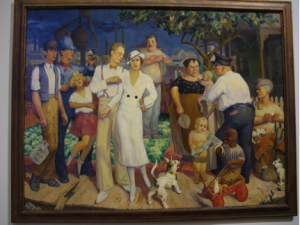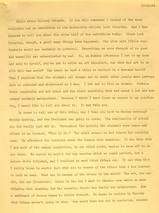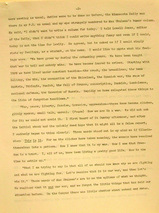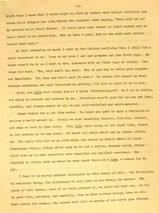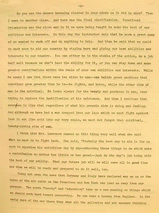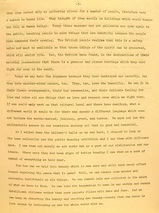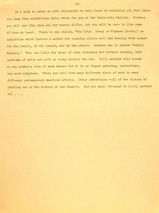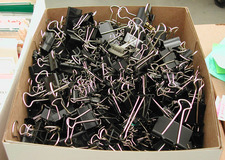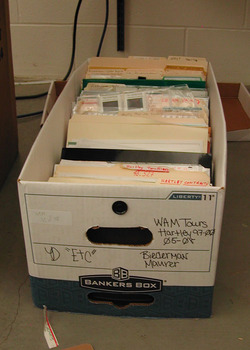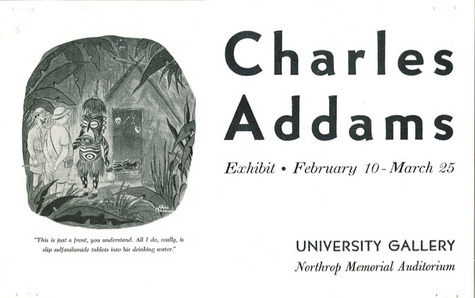In the summer of 1934 (following the official opening of the Little Gallery), President Lotus Coffman initiated the idea for the University to employ the services of artists in the soon-to-be terminated federal Public Works of Art Project (PWAP) program, to capture landscapes of the University campus through brushes and canvas.
PWAP was created in 1933 and was funded by the US Civil Works Administration. In Minnesota, the project was administered by the Minneapolis Institute of Arts under the direction of Russell Plimpton. After the conclusion of the PWAP program in 1934, individual states assumed responsibility for projects still in existence.
On November 5, 1934, Plimpton wrote to Malcolm Willey, Assistant to President Coffman, requesting a description of the work that the artists had completed for the University, stating, “So far as I know, the University of Minnesota was the only one to undertake any continuance of the government’s P.W.A. plan, and I believe that a brief record of it would be especially interesting…”
On November 14, 1934, Willey sent a formal report of the University’s involvement in PWA projects to Plimpton, indicating that, “We now have on exhibition at the Little Gallery all of the works that were done by the group of artists last spring. I hope that you will be able to come over to see them before they are taken down. There is, of course, wide variation in the merit of these pictures, but considering the purpose that we had in mind in inviting the men to campus, I feel that the results are highly satisfactory.”
I would summarize the University’s involvement in the employment of PWA artists, but I feel that Willey’s formal report to Plimpton is… highly satisfactory…
University Art Project Employing PWAThe University of Minnesota has during the past few months been attempting in a quiet way to arouse interest in the fine arts.
There is, to be sure, adequate class work which students may take, but the interest of which we speak is that extending beyond the class room.
President L.D. Coffman early this spring (1934) had raised the question informally of whether or not there were some local artists who might be brought to the campus to paint scenes associated with the University. He had three ideas in mind:
(1) To attract the attention of students by allowing them to see artists at work and dealing with subject matter that was familiar.
(2) To obtain for hanging in various University rooms where students assemble some colorful pictures that would serve to enhance the attractiveness of these rooms.
(3) To stimulate an interest in the work of local artists and lend whatever support he could to their development and local appreciation.
When the PWA art projects were terminating, President Coffman directed a member of his staff to raise with the local committee the possibility of continuing a small group of the artists who would be employed on the federal project by bringing them to the campus at the same rates of pay they had been receiving under PWA.
It was found that this was not only feasible, but that the artists themselves were eager for the chance to continue employment, especially to work on the campus of the University with the assurance that their paintings would be hung.
Accordingly, a sum of money which was available at the University was put aside to employ a small group of local artists. Altogether, seven were brought to the campus for various periods. These were:
Mr. Cameron Booth
Mr. Dewey Albinson
Mr. Elof Wedin
Mr. Erle Loran
Mr. Sydney G. Fossum
Mr. Arnold N. Klagstad
Mr. Stanford Fenelle.It was agreed with the artists that they should receive compensation at approximately the same rate as the PWA had paid them, and that there should be no restrictions as to subject matter other than that they should center in the district in which the University is located – that is, southeast Minneapolis.
Because it was intended to use the work submitted by the artists for decoration of University lounge rooms, assembly rooms, class room corridors, and so forth, it was decided to limit the artists to those working in oil and water color, thus assuring more colorful results.
To supervise the project on the campus, the President appointed a committee of four – Dean Malcolm M. Willey of the University, Mr. Russell Plimpton of the Minneapolis Institute of Arts, Mr. Cameron Booth of the St. Paul School of Art, and Mr. Hudson Walker, curator of the Little Gallery, University of Minnesota. Mr. Booth had given valuable assistance to the PWA work through his technical advice to the artists that had been employed. Mr. Plimpton and Mr. Walker had also been associated with the PWA project, and their membership on the University Committee constituted a continuing link between the two projects.
The committee met one afternoon each week, at which time the artists brought in their work of the preceding seven days. At these meetings it was determined which sketches should be worked up and other matters of a similar nature were discussed.
As a result of the program which extended altogether over six weeks the University acquired 43 water colors of various sizes, 24 small oils chiefly in the nature of sketches, and 14 larger-sized oils. President Coffman then made available sufficient money to frame the entire collection. The watercolors were framed by a commercial gallery in downtown Minneapolis. Frames for the oils were made at the University carpenter shop, following patterns found satisfactory by the PWA committee. The basic costing of whiting the glue was applied in the University paint shop, after which the artists themselves were invited back to finish the frames. For this they were paid at the rate of $1.00 an hour.
The entire collection is now on exhibition at the University of Minnesota Little Gallery, and is attracting a large number of visitors. Already a request has come from the St. Paul Public Library to borrow the collection for a brief showing there.
The Little Gallery at the University of Minnesota is open each week-day and also each evening and Sunday when Symphony concerts are given in Northrop Memorial Auditorium, in which building the Little Gallery is located. The management of the Symphony and the University Artists’s Course has generously donated space in the printed program to call attention to the fact that Symphony patrons are invited during intermission and following the concerts to attend the exhibition. In this way interest in the collection extends beyond the student body on the campus.
Mrs. Ruth Lawrence who is now curator of the Little Gallery has already begun her plans for distribution of the collection among the various University buildings. The largest number of items will go to Pioneer Hall, Sanford Hall, and the College Women’s Dormitory on the farm campus. These are the University residence halls. None of the pictures will be used for office decorations, but will be hung so that students may have contact with them. It is our intention to change the pictures from building to building now and then.”
(from the WAM Collection, Box 109, General Gallery Correspondence)
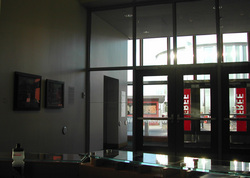 Today, WAM proudly exhibits two of the campus landscapes in the entrance to the museum. Because the shadows in this photograph (taken with full effect of the late afternoon sun) block the landscapes from view, you will just have to stop in to the museum to see them for yourself!
Today, WAM proudly exhibits two of the campus landscapes in the entrance to the museum. Because the shadows in this photograph (taken with full effect of the late afternoon sun) block the landscapes from view, you will just have to stop in to the museum to see them for yourself!
